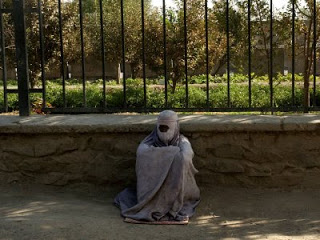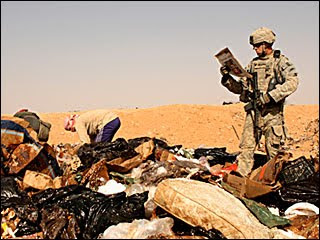Personae of War: How I Write
I can get an episode of TOUR OF DUTY in during lunch. Depending on evening commitments, another short documentary on Iraq or Afghanistan that evening. That’s 40-120 minutes of war television about 4x per week for a person who, prior to my obsession with war personae, watched—no joke—an average of 6 movies per year and absolutely no television. During meals, I read oral histories, realistic war fiction, or current events. Between meals, between teaching, between workouts: I write.
What do I get from all this research?
Consider the people: See enough images of Afghani women shrouded in the burqa and you can tell a story of how they huddle like silent boulders on the sidewalks of Kabul, cowering and speechless with begging cups in their hands. See enough orphaned Iraqi children and you can imagine just how many of their parents were killed in “shock and awe” with our so-called 21st century weapons that lower civilian casualties. See enough video clips of kids playing soccer in relative safety since the U.S. invasion of Afghanistan, and you’ll be hard-pressed to forget those same fields were used for public executions during the Taliban…and that fast, a story will start in your mind: the children kicking at the bones in the dirt, the tip of a femur marking the goal line…
Consider the landscape: Papyrus cane? River-clay bricks? Fig trees? Rice paddies? Yes, and then some. If I’m going to write about a soldier defending a U.S. Army dump and how the local Iraqi gangs throw cardboard over the concertina wire and trick the guards, I’m going to have to know that the papyrus cane grows thick and tall enough for the gangs to gather and prepare their ambushes. Pretty soon, I start to see a short boy…he’s hurling rocks at the gangs as they spar, their linen clothes snapping in the wind as they pound, pound each other over pieces of American trash.
Consider the music. Consider the sunlight. Consider the fifty different shades of brown.
This is how I build these stories: visual immersion and deep imagining, paired with high-stakes material that demands I get the facts right. Later, I read the piece line-by-line for rhythm, authenticity, persona. Next: more research. A night of very little sleep. A different night of odd dreams. Time away from the draft, then: I listen again. I look. I write when the banging around in my brain takes on a tonal quality. I write what I see between the words on the first draft. I write when I hear someone speaking so clearly, I’m convinced there is someone else in the room. Then, the story has begun…
Comments




Great window into what sounds like a very dense (and intense) process. And so many sharp details even in this description…you may not be embedded but you are clearly immersed! Thank you for this one.